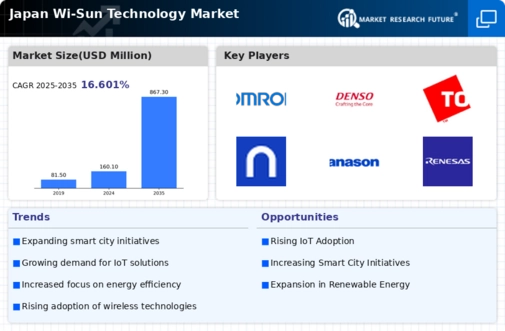Rising Demand for IoT Solutions
The wi sun-technology market in Japan is experiencing a notable surge in demand for Internet of Things (IoT) solutions. This trend is driven by the increasing need for efficient data communication in various sectors, including agriculture, healthcare, and urban management. As businesses and municipalities seek to enhance operational efficiency, the integration of wi sun technology into IoT frameworks appears to be a strategic move. Reports indicate that the IoT market in Japan is projected to grow at a CAGR of approximately 15% through 2026, which could significantly bolster the wi sun-technology market. The ability of wi sun technology to facilitate low-power, long-range communication makes it particularly appealing for IoT applications, thereby driving its adoption across multiple industries.
Government Support for Smart Infrastructure
The Japanese government is actively promoting the development of smart infrastructure, which is likely to benefit the wi sun-technology market. Initiatives aimed at enhancing urban connectivity and sustainability are being prioritized, with substantial investments allocated to smart city projects. The government has set ambitious targets for reducing carbon emissions, which may lead to increased adoption of energy-efficient technologies, including wi sun solutions. In 2025, the government plans to allocate approximately ¥1 trillion to smart infrastructure projects, creating a favorable environment for the wi sun-technology market. This support not only encourages innovation but also fosters collaboration between public and private sectors, potentially accelerating the deployment of wi sun technology in urban settings.
Growing Focus on Environmental Sustainability
There is a growing emphasis on environmental sustainability within Japan, which is influencing the wi sun-technology market. As organizations and consumers alike become more environmentally conscious, the demand for energy-efficient solutions is on the rise. The wi sun technology, known for its low power consumption and minimal environmental impact, aligns well with these sustainability goals. According to recent studies, approximately 70% of Japanese consumers express a preference for eco-friendly technologies, which could drive the adoption of wi sun solutions in various applications. This trend suggests that the wi sun-technology market may see increased investment and innovation as companies strive to meet the evolving expectations of environmentally aware consumers.
Increased Investment in Smart Energy Solutions
Investment in smart energy solutions is on the rise in Japan, which is likely to have a positive impact on the wi sun-technology market. With the government and private sector focusing on energy efficiency and renewable energy sources, the demand for technologies that facilitate smart energy management is growing. The wi sun technology, with its ability to support low-power, wide-area networks, is well-suited for applications in smart grids and energy monitoring systems. Recent reports indicate that the smart energy market in Japan is expected to reach ¥2 trillion by 2027, suggesting a substantial opportunity for the wi sun-technology market to capitalize on this trend. This investment climate may encourage innovation and the development of new applications, further driving market growth.
Advancements in Wireless Communication Technologies
The wi sun-technology market is poised for growth due to advancements in wireless communication technologies. Innovations in radio frequency and network protocols are enhancing the capabilities of wi sun technology, making it more efficient and reliable. These advancements are particularly relevant in Japan, where the demand for seamless connectivity in smart devices is escalating. The introduction of new standards and improved interoperability among devices could lead to a more robust wi sun-technology market. As companies invest in research and development, the potential for enhanced performance and expanded applications of wi sun technology appears promising, potentially attracting new players to the market.























Leave a Comment